Clean energy discussion papers
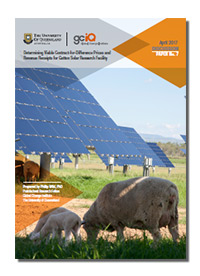 Discussion Paper No. 7
Discussion Paper No. 7
Determining Viable Contract-for-Difference Prices and Revenue Receipts for Gatton Solar Research Facility (PDF, 2.7 MB)
Abstract
In this paper, we investigate the role that a Contract-for-Difference (CFD) feed-in tariff might play in underpinning increased investment in renewable energy in Australia. We investigate two particular CFD designs: two-way and a one-way CFD. We develop a financial model that is capable of determining commercially viable CFD strike prices for different renewable energy projects. In this modelling, we take account of revenue from wholesale electricity market and renewable energy certificate sales. We also include capital and operational costs of the project including distribution of funds for holders of equity and debt. We present findings bases on analysis of the solar array located at UQ Campus Gatton Australia, employing a typical meteorological year framework. Our major findings are that governments will prefer a two-way CFD design and Single-Axis tracking solar array technology. Project proponents, however, will strongly prefer a one-way CFD design.
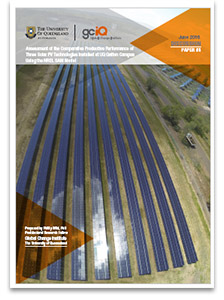 Discussion Paper No. 6
Discussion Paper No. 6
Projecting Solar PV Yield of the Solar Array Installed at UQ Gatton Campus Using NREL’s SAM Model (PDF, 2.8 MB)
Abstract
The viability of utility scale solar PV farms will depend critically upon the annual production of such farms. A crucial determinant of solar PV yield will be prevailing solar irradiance and weather conditions. In Australia, the combined effects of weather relating to solar irradiance, temperature and rainfall on PV yield is likely to be closely linked to the El Niño–Southern Oscillation ENSO cycle. To investigate this we use NREL’s SAM model to simulate electricity production from a 3.275 megawatt pilot solar PV plant at The University of Queensland’s Gatton Campus. A key finding was that the best simulated PV yields were obtained during 2013 and 2014, when ENSO neutral conditions but with an El Nino bias prevailed. The worst years were 2010 and 2011 which were characterised by moderate and weak La Nina phases of ENSO. All other years considered had average PV yield outcomes including 2015 which experienced a very strong El Nino event.
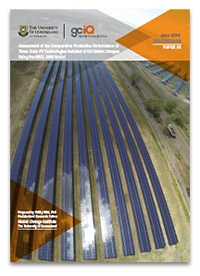 Discussion Paper No. 5
Discussion Paper No. 5
Assessment of the Comparative Productive Performance of Three Solar PV Technologies Installed at UQ Gatton Campus Using The NREL SAM Model (PDF, 2.6 MB)
Abstract
The economic assessment of the viability of different types of solar PV tracking technologies centres on assessment of whether the annual production of the different tracking technologies is increased enough to compensate for the higher cost of installation and operational expenditures incurred by the tracking systems. To investigate this issue, we use the NREL’s SAM model to simulate electricity production from three representative solar PV systems installed at Gatton. In these simulations we use hourly solar irradiance, weather and surface albedo data, technical data relating to both module and inverter characteristics and impacts associated with module soiling and near-object shading. A key finding was that over the period 2007 to 2015, average increases in annual production of between 23.9 and 24.3 per cent and 38.0 and 39.1 per cent were obtained for Single Axis and Dual Axis tracking systems relative to the Fixed Tilt system.
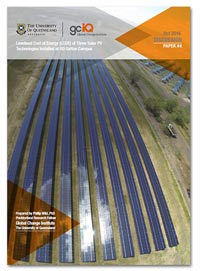
Discussion Paper No. 4
Levelised Cost of Energy (LCOE) of Three Solar PV Technologies Installed at UQ Gatton Campus (PDF, 2.7 MB)
Abstract
Economic assessment of the viability of different types of solar PV tracking technologies centres on assessment of whether the annual production of the different tracking technologies is increased enough relative to a benchmark Fixed Tilt system to compensate for the higher cost of installation and operation incurred by the tracking systems. To investigate this issue, we calculated the LCOE of three representative solar PV systems. These calculations depend crucially on assumptions made about ($/kW) construction costs as well as annual capacity factors of the three solar technologies considered. A key finding was that the Single Axis Tracking technology was the most cost competitive, followed by a Fixed Tilt system. A Dual Axis Tracking system was the least cost competitive technology of those considered. We also considered how LCOE could underpin a ‘Contract-for-Difference’ feed-in tariff scheme.
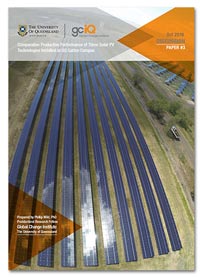
Discussion Paper No. 3
Comparative Productive Performance of Three Solar PV Technologies Installed at UQ Gatton Campus (PDF, 3.1 MB)
Abstract
Economic assessment of the viability of different types of solar PV tracking technologies centres on assessment of whether the annual production of the different tracking technologies is increased enough relative to a benchmark Fixed Tilt system to compensate for the higher installation and operational costs incurred by the tracking systems. To investigate this issue, we use the PVsyst software to simulate electricity production from three representative solar PV systems installed at Gatton. In these simulations we use hourly solar irradiance, weather and surface albedo data, technical data relating to both module and inverter characteristics and impacts associated with module soiling and shading. A key finding was that over the period 2007 to 2015, average increases in simulated annual production of between 17.7 and 17.9 per cent and 36.5 and 36.7 per cent were obtained for Single-Axis and Dual-Axis tracking systems relative to the Fixed Tilt system.
